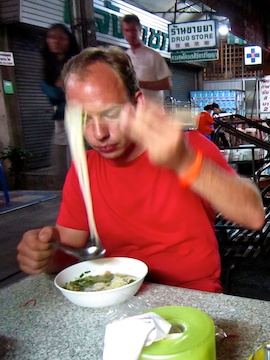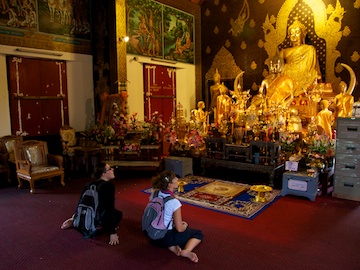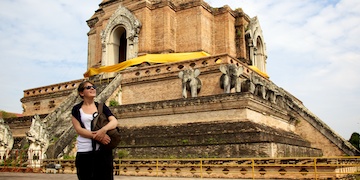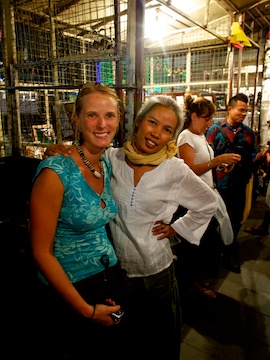Day 10: Northern Territories
 Saturday, January 8, 2011 at 11:55PM
Saturday, January 8, 2011 at 11:55PM  Strictly speaking, Thailand has quite a few cities more populous than Chiang Mai. When it comes to cultural influence however, the capital of Northern Thailand is second only to Bangkok. A commercial and cultural crossroad older than the kingdom itself, it recently became known for the ASEAN+3 Chiang Mai initiative, and is currently bidding to host the 2020 World Expo.
Strictly speaking, Thailand has quite a few cities more populous than Chiang Mai. When it comes to cultural influence however, the capital of Northern Thailand is second only to Bangkok. A commercial and cultural crossroad older than the kingdom itself, it recently became known for the ASEAN+3 Chiang Mai initiative, and is currently bidding to host the 2020 World Expo.
I like Chiang Mai a lot. To me it feels uncannily like Oxford, England, another of my favorite small towns. It is hard to explain how a merchant and craftsmen center in Indochina can feel similar to the crown jewel of Christian university towns, but this is indeed so. Both are the same perfect size : big enough to have interesting history, architecture and events, small enough that you don't get the suffocating feeling common in huge metropolises. Both cities ooze venerability. Both have the very best fast foods of their respective country (although in the case of Oxford this doesn't mean all that much.) Both sustain healthy and numerous populations of rats and cockroaches. I love them.
 In any case, Chiang Mai is the favorite destination for westerners feeling overwhelmed by Bangkok's sprawl and bored with the one-dimensional beach resorts of the South. So we found ourself, after a night in the cheapest but worst hostel of the entire trip, walking through the old town. Chiang Mai is known as the city of Wats, the Thai name for buddhist monastery temples, of which it has more than three hundred. We only saw a couple during our relaxed amble inside the walled old town, my favorite being Wat Chedi Luang. I loved it instantly for its atypical brick pyramid guarded by elephants and hydras, although it is better known for its side altars containing mummified monks (or, conceivably, wax statues posing as mummified monks) preserved in plastic cubes, in front of which worshippers lined up to burn incense and sit meditatively, possibly reflecting on their own mortality, whether anyone will come visit their preserved corpse two centuries from now, and whether that made any difference.
In any case, Chiang Mai is the favorite destination for westerners feeling overwhelmed by Bangkok's sprawl and bored with the one-dimensional beach resorts of the South. So we found ourself, after a night in the cheapest but worst hostel of the entire trip, walking through the old town. Chiang Mai is known as the city of Wats, the Thai name for buddhist monastery temples, of which it has more than three hundred. We only saw a couple during our relaxed amble inside the walled old town, my favorite being Wat Chedi Luang. I loved it instantly for its atypical brick pyramid guarded by elephants and hydras, although it is better known for its side altars containing mummified monks (or, conceivably, wax statues posing as mummified monks) preserved in plastic cubes, in front of which worshippers lined up to burn incense and sit meditatively, possibly reflecting on their own mortality, whether anyone will come visit their preserved corpse two centuries from now, and whether that made any difference.

Rounding up the afternoon were a short songthaew trip to the out-of-town Wat Chet Yot and its beautiful gold-leafed buddhas, an ambitious negotiation at a travel agency for tomorrow's day-trip, and, in my case, a rather long stay at Black Canyon Coffee drinking green tea with milk and editing photos.
 We spent most of the evening at a night market, one of the many Chiang Mai holds all week long. All night markets in Thailand are great, with awesome street food and beautiful antiques at a good price, assuming you're ready to barter. If, like me, you find curio and memorabilia to be very poor use of shelf space, you can always fall back on the food. I passed on the fried crickets, but did take a chance on a glass of rice noodles floating in green-sludge, which was somewhat disappointing, but a big plate of sushis more than made up for that.
We spent most of the evening at a night market, one of the many Chiang Mai holds all week long. All night markets in Thailand are great, with awesome street food and beautiful antiques at a good price, assuming you're ready to barter. If, like me, you find curio and memorabilia to be very poor use of shelf space, you can always fall back on the food. I passed on the fried crickets, but did take a chance on a glass of rice noodles floating in green-sludge, which was somewhat disappointing, but a big plate of sushis more than made up for that.
At one stand Jubib and I spent nearly twenty minutes chatting with one of the vendors, a cheerful woman of indeterminate age. She was a Mon, one of the many dirt poor ethnic minorities of rural Thailand. She lived in a village a dozen kilometers from Chiang Mai, where almost everybody is illiterate. She'd spent most of her life working on the family farm, and still did for most of the daylight hours, but some time ago she started coming to Chiang Mai in the evening to sell cloth. This allowed her to meet many people, including foreigners, and this way she taught herself English, which she spoke very decently. With the money she earned from her stand, she also managed to travel a bit, eventually visiting Lao, Malaysia and Yunnan. Considering most of the Mons barely make enough to ever venture outside the province, her story is remarkable. I really need to do more with my life.
Reader Comments